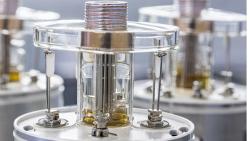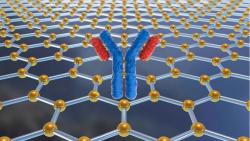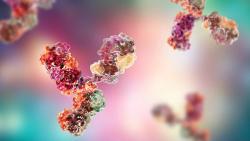
OR WAIT null SECS
- About Us
- Advertise
- Editorial Information
- Contact Us
- Do Not Sell My Personal Information
- Privacy Policy
- Terms and Conditions
© 2024 MJH Life Sciences™ and BioPharm International. All rights reserved.
The Renaissance of Protein Purification
The polishing process-unlike capturing-is beginning to benefit from technological advances.
Throughout the ages, great sculptors like Michelangelo have said that their work is about taking a block of marble and freeing a form that is already there. All the artist needs to do is remove everything that does not belong in the masterpiece.
The work of downstream processing scientists is similar. Instead of stone, their artistic medium is a colored, and sometimes turbid, soluion. Purification must remove process contaminants and produce a pure end product. It is that simple.
Courtesy Sartorius AG
In reality, there is a conflict between upstream and downstream processes resulting from the industry's strength in fermentation and weakness in purification. The consequences are dramatic. Monoclonal antibodies (MAbs)—the fastest growing biopharmaceutical market segment, with predicted annual sales of $20 billion by 2010—are an example. Demand has already reached 6 metric tons this year.
Fortunately, large amounts of raw material are accessible as a result of sufficient manufacturing capacity that has become available recently, combined with significant productivity increases in upstream processes.1 Experts claim that even after recent dramatic improvements from mg/L to g/L of antibody titers in mammalian cell culture, the best is yet to come.2 From the early days of MAb manufacturing, we know that physiological levels of up to 20 g/L can be achieved in mouse ascites. That is probably the long-term goal we are looking at.
Unfortunately, we have not seen the same speed of progress further downstream. Downstream operations have always been in a sandwich position. Typically, senior management focuses on the initial phase of the process, where most investment goes and where the raw material is generated. The other typical focus is formulation, as the outlet for the drug product. For years, downstream simply had to deliver; nobody asked how. Now, as the bottleneck becomes obvious, there is a lot of pressure on purification. We are in a technology crisis, and protein purification must make a comeback.3
Today's downstream processing operations generally focus on two main areas: a) the initial recovery phase, including capturing, where bulk purity is achieved; and b) the subsequent polishing phase, which adds safety through orthogonal strategies for impurity and pathogen clearance.
It is relatively easy to identify the bottlenecks in the process. Early recovery, including harvesting, cell removal, and clarification, is not a problem. These steps can be operated with robust technology that processes high volumes in the biopharmaceutical industry; and even larger volumes—beyond the 100,000-L scale—in food, beverage, and technical enzyme manufacturing.
But further downstream, for example in capturing, processes are dominated by chromatography with its inherent limitations. Very large scale chromatography is technically feasible, but big columns encounter big problems and current upstream titer developments are pushing biochromatography beyond its physical and economic limits.
Protein A is the work horse in antibody separation, and accounts for up to 10% of the overall costs; individual column fillings cost millions of US dollars but still cannot cope with the volume of common fermenter batches. Despite such problems, however, Protein A offers unmet specificity, so it will continue to be the industry standard until a breakthrough arises from the second or third generations of the mimetic ligands that are currently available.
Because state-of-the-art capturing, including affinity chromatography, yields material that is >98% pure, polishing efforts focus on removing pathogens and trace contaminants. Because this area does not receive much attention, polishing does not seem to represent a bottleneck. In reality, it does, because in the standard approach— removing typical process-derived contaminants with anion exchangers in flow-through mode—the flow rate, rather than binding capacity, becomes the limiting factor. Thus, we run into a problem: to increase the flow rate, we need very large chromatography columns, which require very large quantities of expensive resins.
Fortunately, the polishing area—unlike the capture area—is beginning to benefit from advances such as disposable chromatography systems, which have been implemented in a number of processes.4 In one example, a disposable 0.5-L membrane can remove process-derived impurities such as DNA, viruses, and endotoxins from a 1000-L feed stream just as well as a stainless steel column that is a hundred times larger. Results from a case study examining the economics of such systems demonstrated that disposable equipment can provide a cost savings up to 70% in MAb polishing.5 The disposable options benefit from lower capital investment and significantly reduced material costs because these small devices consume 95% less buffer. And for viral clearance, disposable chromatography offers additional advantages beyond cost savings: it eliminates the need to carry out virus carryover and cleaning validation studies.
In many processes, virus filtration (the other main method for virus removal) is the most expensive downstream step, accounting for up to 40% of costs. Thus, it is understandable that this step is a target for process optimization. Overall productivity, however, is not only a matter of initial flow rate, but also of total throughput and sensitivity to aggregate and impurity level. A viral clearance study with at least four viruses for late-stage development is state-of-the-art, and log reduction values (LRVs) of 4 and higher are hygienic factors. More interesting, but also less trivial, are LRVs that are independent of the flow decay of the filter.
Other Current Trends in Bioseparation
A clear trend in bioseparations is to combine steps, even eliminating the need for staging tanks and hold-up volumes between unit operations. Orthogonal strategies for each objective are key to achieving industry goals for yield and quality.
With increasing biomass in cell culture, high-productivity harvesting procedures are enticing, and there is a lot of interaction among the three unit operations of centrifugation, cross flow, and depth filtration. Eventually, we will see more integrated processes, such as expanded bed adsorption, ideally in disposable formats. For monoclonal antibody manufacturing, for example, we need to develop processes that require only two column steps followed by a rational filtration train, in which every step addresses the removal of a certain contaminant.
Polishing before capturing sounds provocative, but is becoming more common. This approach protects the protein A column and prevents the column eluate from precipitating by removing certain lipoproteins from the feed stream. These concepts can be custom designed with smart membranes that remove individual contaminants like proteases very specifically and early in the process to yield stable storage forms.
In chromatography, attempts are being made to make resins look more like membranes and vice versa. It makes much more sense to accept the limitations of both technologies. They each are great in their individual core application areas and deserve an integrated approach, for example, by using a chromatography train (capturing phase) followed by a filtration train (polishing phase). Capturing will always require high dynamic capacity and will be dominated by resins (with the exceptions of large molecules and high dilutions), whereas polishing is going to be the domain of charged membranes.
Thus, we are seeing many paradigm shifts in bioseparations, including the trend toward disposables to save costs. I predict that in a number of years, polishing applications will be dominated by disposable concepts. But much more is required. If downstream processing had kept pace with the revolution in fermentation, chromatographic separations would require only minutes, not hours. Because this is not feasible, we must seek alternatives. Bioseparation is desperate for high-throughput, high-productivity unit operations. One place to start would be to copy what has been done in food, beverage, and technical enzyme manufacturing.
In sum, robust and reliable methods such as extraction, precipitation, and crystallization deserve a renaissance. Michelangelo, although considered a master, was said to be constantly dissatisfied with himself. He probably realized that complacency is a dangerous enemy. We should take our cue from him.
References
1. BioPlan Associates. 3rd annual report & survey on biopharmaceutical manufacturing capacity and production. June 2005.
2. Wurm FM, Production of recombinant protein therapeutics in cultivated mammalian cells. Nature Biotechnol. 2004; 22: 1393–1398.
3. Aldridge S. Downstream processing needs a boost. GEN 2006; 26(1).
4. Zhou JX, Tressel T. Basic concepts in Q membrane chroma-tography for large scale antibody production. Biotechnol. Progress. 2006; 22(2):341–349.
5. Sinclair A. Disposable technologies—impact on biomanu-facturing. London: Institution of Chemical Engineers; 2005.
Related Content:



